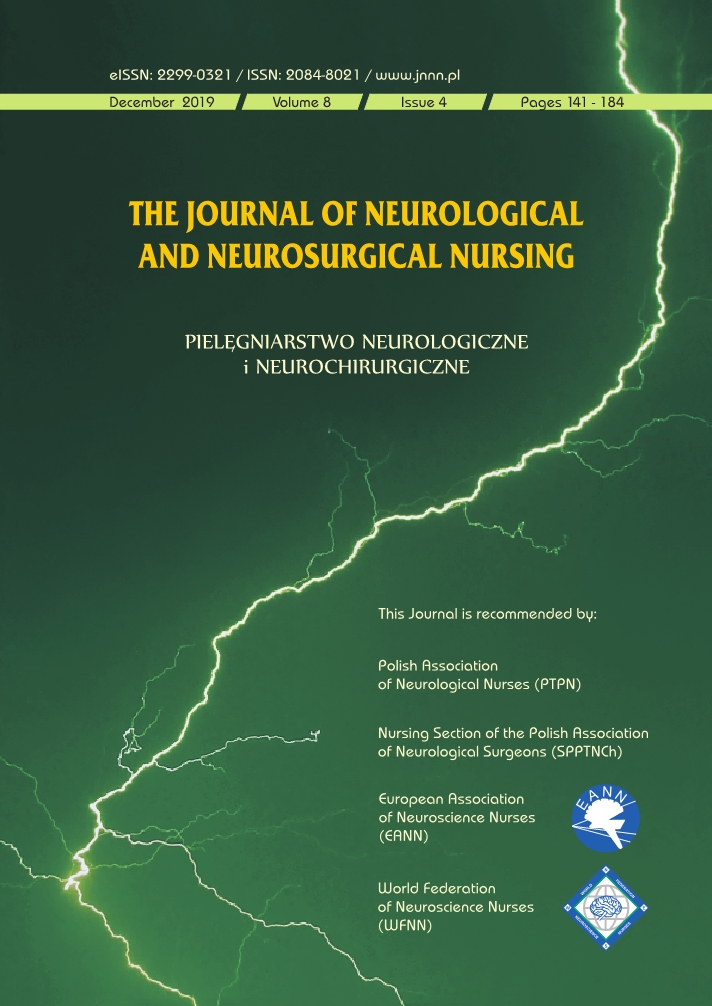Tromboliza i trombektomia mechaniczna jako wiodące sposoby leczenia ostrego udaru niedokrwiennego mózgu
DOI:
https://doi.org/10.15225/PNN.2019.8.4.6Słowa kluczowe
udar niedokrwienny, leczenie, tromboliza, trombektomiaAbstrakt
Choroby naczyniowe mózgu, a zwłaszcza udary, to nadal bardzo poważny problem zdrowia publicznego i medycyny. Świat nadal stoi w obliczu epidemii udaru mózgu. Przy rosnącym na całym świecie obciążeniu udarowym istnieje ciągła potrzeba zrozumienia cech tej choroby i jej wpływu w różnych krajach. Pomimo znacznej poprawy w zakresie pierwotnej profilaktyki i skuteczności leczenia w ciągu ostatnich dziesięcioleci udar jest nadal wyniszczającą chorobą. Wczesne leczenie jest kluczem do pomyślnego powrotu do zdrowia pacjentów z udarem niedokrwiennym.
Celem pracy jest ukazanie najskuteczniejszych metod leczenia pacjentów w ostrej fazie udaru mózgu niedokrwiennego. (PNN 2019;8(4):177–181)
Bibliografia
Béjot Y., Bailly H., Durier J., Giroud M. Epidemiology of stroke in Europe and trends for the 21st century. Presse Med. 2016;45(12 Pt 2):e391-e398.
Feigin V.L., Norrving B., Mensah G.A. Global Burden of Stroke. Circ Res. 2017;120(3):439–448.
Mashni S.K., O’Neal C.R., Abner E., Lee J., Fraser J.F. Time Intervals for Direct Versus Transfer Cases of Thrombectomy for Stroke in a Primarily Rural System of Care. J Stroke Cerebrovasc Dis. 2020:104689.
Smelkowska A., Pniewska J., Grabowska-Fudala B., Jaracz K. Rola pielęgniarki w leczeniu trombolitycznym w udarze niedokrwiennym mózgu — opis przypadku. Pielęg Chir Angiol. 2012;2:78–82.
Danoun O., Sachar P., Rajamani K. Thrombolysis for Acute Ischemic Stroke After Protamine Reversal of Heparin. Am J Ther. 2018;25(5):e552–e554.
Rabinstein A.A. Update on Treatment of Acute Ischemic Stroke. Continuum (Minneap Minn). 2020;26(2):268–286.
Prabhakaran S., Ruff I., Bernstein R.A. Acute stroke intervention: a systematic review. JAMA. 2015;313(14):1451–1462.
Mehrpour M., Afrakhte M., Shojaei S.F. et al. Factors predicting the outcome of intravenous thrombolysis in stroke patients before rt-PA administration. Caspian J Intern Med. 2019;10(4):424–430.
Huang Y.H., Zhuo S.T., Chen Y.F. et al. Factors influencing clinical outcomes of acute ischemic stroke treated with intravenous recombinant tissue plasminogen activator. Chin Med J (Engl). 2013;126(24):4685–4690.
Kamal N., Smith E.E., Jeerakathil T., Hill M.D. Thrombolysis: Improving door-to-needle times for ischemic stroke treatment — A narrative review. Int J Stroke. 2018;13(3):268–276.
Benjamin E.J., Blaha M.J., Chiuve S.E. et al. Heart Disease and Stroke Statistics-2017 Update: A Report From the American Heart Association. Circulation. 2017;135(10):e146–e603.
Goyal M., Almekhlafi M., Dippel D.W. et al. Rapid Alteplase Administration Improves Functional Outcomes in Patients With Stroke due to Large Vessel Occlusions. Stroke. 2019;50(3):645–651.
Hawkes M.A., Carpani F., Farez M.F., Ameriso S.F. Door-to-Needle Time in Acute Stroke Treatment and the “July Effect”. Neurohospitalist. 2018;8(1):24–28.
Raina A., Trivedi M., Kate M., Kumar L., Erat Sreedharan S., Sylaja P.N. Temporal sustainability of guideline based door-to-needle times for intravenous thrombolysis for acute ischemic stroke. J Clin Neurosci. 2020. doi: 10.1016/j.jocn.2020.02.002.
Papanagiotou P., Ntaios G. Endovascular Thrombectomy in Acute Ischemic Stroke. Circ Cardiovasc Interv. 2018;11(1):e005362.
Powers W.J., Rabinstein A.A., Ackerson T. et al. 2018 Guidelines for the Early Management of Patients With Acute Ischemic Stroke: A Guideline for Healthcare Professionals From the American Heart Association/American Stroke Association. Stroke. 2018;49(3):e46–e110.
Goyal M., Menon B.K., van Zwam W.H. et al. Endovascular thrombectomy after large-vessel ischaemic stroke: a meta-analysis of individual patient data from five randomised trials. Lancet. 2016;387(10029):1723–1731.
Urbach H., Kellner E., Egger K. Acute Stroke Imaging in the Era of the DAWN, DEFUSE 3 and WAKE-UP Study Findings. European Neurological Review. 2019;14(1):24–27.
Wang A., Abramowicz A.E. Endovascular thrombectomy in acute ischemic stroke: new treatment guide. Curr Opin Anaesthesiol. 2018;31(4):473–480.
Nogueira R.G., Jadhav A.P., Haussen D.C. et al. Thrombectomy 6 to 24 Hours after Stroke with a Mismatch between Deficit and Infarct. N Engl J Med. 2018;378(1):11–21.
Albers G.W., Marks M.P., Kemp S. et al. Thrombectomy for Stroke at 6 to 16 Hours with Selection by Perfusion Imaging. N Engl J Med. 2018;378(8):708–718.
Thomalla G., Fiebach J.B., Østergaard L. et al. A multicenter, randomized, double-blind, placebo-controlled trial to test efficacy and safety of magnetic resonance imaging-based thrombolysis in wake-up stroke (WAKE-UP). Int J Stroke. 2014;9(6):829–836.
Thomalla G., Simonsen C.Z., Boutitie F. et al. MRI-Guided Thrombolysis for Stroke with Unknown Time of Onset. N Engl J Med. 2018;379(7):611–622.
Kobayashi A., Niewada M., Członkowska A., Ryglewicz D., Trojanowski T., Fiszer U. Trombektomia w udarze niedokrwiennym mózgu — stanowisko Komitetu Nauk Neurologicznych Polskiej Akademii Nauk. Nauka. 2016;3:161–168.
Lavine S.D., Cockroft K., Hoh B. et al. Training Guidelines for Endovascular Ischemic Stroke Intervention: An International Multi-Society Consensus Document. AJNR Am J Neuroradiol. 2016;37(4):E31–E34.
Pobrania
Opublikowane
Jak cytować
Numer
Dział
Licencja

Utwór dostępny jest na licencji Creative Commons Uznanie autorstwa – Bez utworów zależnych 4.0 Międzynarodowe.
Statystyki
Liczba wyświetleń i pobrań: 366
Liczba cytowań: 0
